|
|
LOUIS JOLLIET AND JACQUES MARQUETTE: DISCOVERING THE MISSISSIPPILouis Jolliet (1645 - 1700)
|
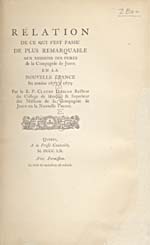 Title page of one of the Jesuit Relations Copyright/Source |
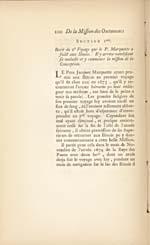 Page from one of the Jesuit Relations Copyright/Source |
|
"Le Pere Jacques Marquette ayant promis aux Ilinois au premier voyage qu'il fit ches eux en 1673, qu'il y retourneroit l'année suivante po leur enseigner sa parole. Les grandes fatigues de son premier voyage luy avoient causé un flux de sang, et l'avoient tellement abbattu, qu'il estoit hors d'esperance d'entreprendre un 2nd voyage. Cependant son mal ayant diminué, et presque entierement cessé sur la fin de l'este de l'année suivante, il obtint permission de ses Superieurs de retourner aux Ilinois po y donner commencement a cette belle Mission. [Dablon, [1860], 100] |
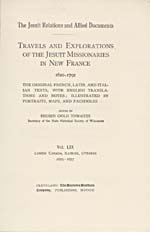 Title page of Thwaites' translation of the Jesuit Relations Copyright/Source |
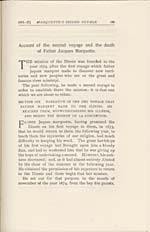 Page from Thwaites' translation of the Jesuit Relations Copyright/Source |
|
"Father Jacques Marquette, having promised the Ilinois on his first voyage to them, in 1673, that he would return to them the following year, to teach them the mysteries of our religion, had much difficulty in keeping his word. The great hardships of his first voyage had Brought upon him a bloody flux, and had so weakened him that he was giving up the hope of undertaking a second. However, his sickness decreased; and, as it had almost entirely Abated by the close of the summer in the following year, He obtained the permission of his superiors to return to the Ilinois and there begin that fair mission. [Thwaites, [1900], 59, 185] |
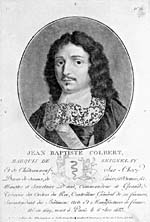 |
| Jean-Baptiste Colbert, Minister of the Marine Copyright/Source |
Jolliet spent the winter at Sault Ste. Marie writing the journal of his voyage and drawing and copying maps. On the way back to the colony, his canoe capsized going down the Lachine Rapids near Montreal. An Illinois slave who had been given to Jolliet as well as two Frenchmen drowned. His box of documents disappeared forever and he himself was barely saved. Compounding this misfortune, the copies of these documents that he had left behind at Sault Ste. Marie were burned in a fire. The only account of this voyage that has come down to us is a narrative and map that Father Marquette sent Claude Dablon. The authorities were disappointed in finding that the Mississippi did not flow to Asia. The Minister of the Marine, Jean-Baptiste Colbert, refused to allow Jolliet to settle in Illinois, as his policy disallowing trade west of Montreal was still in effect.
Jolliet did not give up exploring. In 1675, he married Claire-Françoise Bissot -- the daughter of a trafficker on the north shore -- and undertook fur trading in that part of the country. Very quickly, he became one of the influential merchants of New France, consulted by the Governor and his peers when they needed to make important decisions.
In 1679, Jolliet was sent to Hudson's Bay, which he reached via the Saguenay, a route known since 1672 thanks to the voyage of the Jesuit Charles Albanel. At Fort Rupert, he met the first governor of the Hudson's Bay Company, Charles Bayly, who, having heard of his discoveries, invited him to serve the English. Jolliet returned from this voyage convinced that, in Hudson's Bay, the English had the best possible beaver-fur trade going, and discreetly suggested that the King prevent the English from setting themselves up any further as this could be disastrous for New France. Jolliet also recognized that the Hudson's Bay Company's success could adversely affect his own business at Mistassini. The following year, Jolliet got the concession for Anticosti Island where he wanted to set up cod fishing and seal and whale hunting. As of 1680 or 1681, he spent the warm months with his family overseeing the fishing. In winter, he gave courses in hydrography at the Quebec Seminary.
In 1694, Jolliet undertook a voyage of exploration along the north shore of Labrador, where he went as far as 56º8' north latitude. Several explorers, including Davis, Waymouth, Knight and Bourdon, as well as many fishermen, had already been to this area but none of them had described it precisely or mapped it. Leaving the Mingan Islands in June, Jolliet mapped the coast all summer. His journal of the voyage includes a description of the coast of Labrador and its inhabitants as well as 16 draft maps. This is the oldest known description of the shore between Cape Charles and Zoar, giving it historical importance. Moreover, in 1694, it was the most complete and most precise written description of the Inuit.
Jolliet was one of the best ship's pilots in the country. Accordingly, in 1695, Governor Frontenac sent him to pilot the Charente, a ship that left late in the fall, believing Jolliet to be the only person capable of the task. Jolliet returned from this voyage but there is no trace of him for the three final years of his life. During his lifetime, Jolliet was internationally renowned. Everywhere in Europe, works have celebrated his discovery of the Mississippi but no one knows where or on what day he died in the summer of 1700.